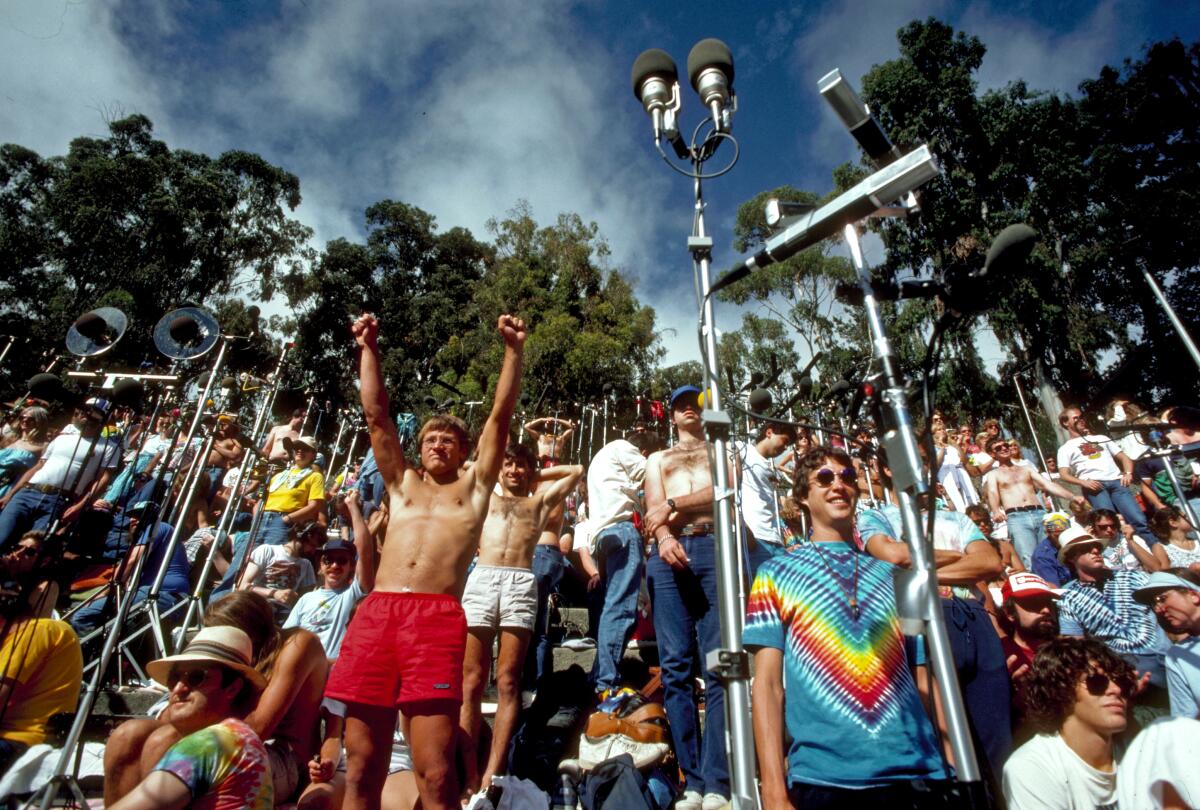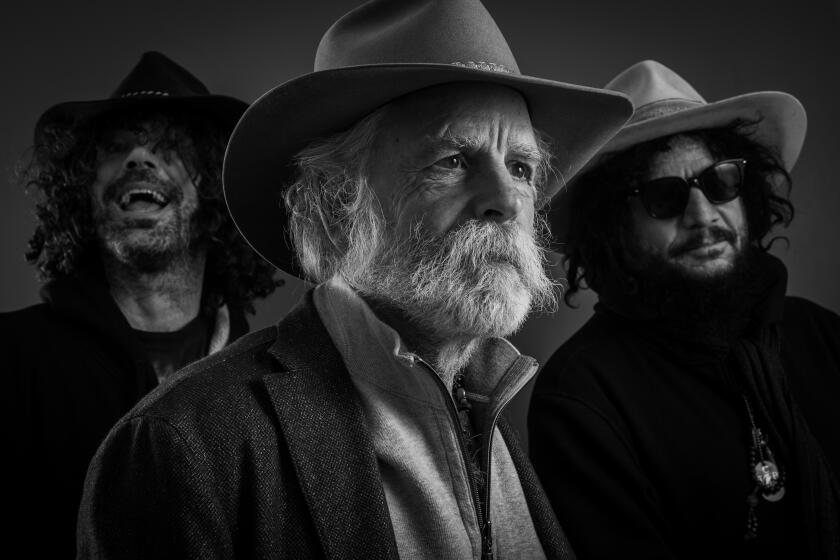Review: The Grateful Dead memories rise again in a book celebrating bootleg concert tapers

- Share via
When I first listened to the Grateful Dead’s seminal live album, 1969’s “Live/Dead,” I heard little but cacophonous jams, the aural equivalent of a bad acid trip. Sure, I liked ear candy like “Sugar Magnolia” and “Casey Jones,” but I really didn’t get the band or the cult-like devotion of their fans. Then I saw them live.
As I entered the Swing Auditorium in San Bernardino in late 1980, I was immediately struck by the crowd, a sea of tie dye and long hair, with twirling women crowned by garlands of flowers and men swaying to and fro, as though plugged into an invisible electrical current. A phalanx of Hells Angels in leather jackets nodded in unison. A cloud of marijuana enveloped the arena. I felt like the only straight at a 1960s love-in.
Slowly, I keyed into lead guitarist Jerry Garcia’s inventive melodies, the rock-solid rhythm section and the transcendent improvisations, a heady mix of country, rock, psychedelia, jazz, bluegrass, and blues that ranged wild and free. Add Garcia’s and rhythm guitarist Bob Weir’s expressive vocals to the mix, and musical magic ensued. By the end of the concert, I had danced with the Dead.
Mark A. Rodriguez’s new book, “After All Is Said and Done: Taping the Grateful Dead 1965-1995,” kind of works the same way.
Rodriguez, an artist who has built sculptures from recordings of Dead shows, gives readers a kaleidoscope view of the band’s storied tapers. He thoroughly explores their obsessive quest for the lost chord and how they contributed to several cottage industries that grew up alongside the Dead, ranging from fanzines that published setlists to tape-trading exchanges to entrepreneurs who churned out cassette covers decorated with dancing bears, Ice Cream Kid and lots of skulls and roses.
Rodriguez tells his compelling story through present-day interviews with members of the Dead’s inner circle such as former band publicist Dennis McNally and legendary tapers Jim and Doug Oade; old press clippings; group meeting minutes; and assorted ephemera like pictures of the band and hundreds of colorful cassette covers, beginning with the Dead’s Feb. 25, 1966, appearance at L.A.’s Ivar Theater and ending with their July 9, 1995, show at Chicago’s Soldier Field, the Dead’s last with Garcia.

Like my introduction to the Dead, “After All Is Said And Done” made a tepid first impression. Despite the massive tome’s beautiful cover and stunning graphics, it contains no current interviews with band members. No short bios of the many insiders interviewed. No lists of the Dead’s all-time shows. I also found the book’s size – it’s shaped like an LP or a reel-to-reel tape box – off-putting. Is it a coffee table book? A scrapbook? WTH?
Then I dug in. By the end of this edifying and engaging book , I felt like I had fallen through a time portal and re-entered the Dead world of yesteryear. With apologies to Phish fans, no group has ever been as mythologized, idolized and memorialized as the Dead. The tapers were there to capture it all.
Dead lore has it that the band not only tolerated tapers but welcomed them. Garcia, Captain Trips himself, famously said in a 1989 interview that “When I’m done with it [the music], it’s theirs.” As Rodriguez chronicles, the group’s relationship to the taping brigade was far more complex.
Tapers began appearing on the scene in the 1960s, their numbers growing throughout the ‘70s in tandem with the band’s popularity. With security, especially on the East Coast, tight, they came up with ingenious ways of sneaking their equipment into shows, including hiding gear under women’s dresses.
Record companies hated tapers because they erroneously feared they cut into record sales. In fact, their bootlegged recordings converted scores of listeners into Deadheads. The tapers themselves, the Dead’s legendary sound engineer Dan Healy said in a 2008 interview, were also among the band’s most reliable customers. “People that love you so much that they come to record you, they are the first ones in line to buy your records when they come out,” he said.
But the fans and group became increasingly wary. Tapers sometimes became belligerent when people talked around them, admonishing them to keep quiet. They and their gear—a sea of microphones and recording equipment—often blocked concertgoers’, and even sound engineers, view of the stage. The Dead had a problem on their hands.
As Rodriguez chronicles, they came up with the perfect solution. In 1984, the band created a taper’s section behind the soundboard. Seats that would have otherwise gone unsold because of poor sightlines became coveted—and made a little extra for the band. The Dead even created special tickets that tapers could buy through the group’s mail-order ticket office.
After all is said and done, tapers played an integral role in the Grateful Dead’s ecosystem.
“Throughout the show, their little lights would dance in unison with the rest of the fans, and then, the treasure captured, everything would get packed squarely away and carried off to join the taped documents of previous journeys,” Trixie Garcia, Jerry Garcia’s daughter, writes in the book’s foreword. “Tapes would be shared and worlds would be expanded, minds opened by the gift of revelry captured on cassette.”
Books
After All Is Said And Done: Taping The Grateful Dead 1965 – 1995”
After All Is Said And Done: Taping The Grateful Dead 1965 – 1995”
by Mark A Rodriguez
Anthology Editions
320 pages
$38.55
If you buy books linked on our site, The Times may earn a commission from Bookshop.org, whose fees support independent bookstores.
More to Read
Sign up for our Book Club newsletter
Get the latest news, events and more from the Los Angeles Times Book Club, and help us get L.A. reading and talking.
You may occasionally receive promotional content from the Los Angeles Times.











